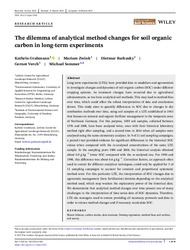The dilemma of analytical method changes for soil organic carbon in long‐term experiments
Persistent URL: http://resolver.sub.uni-goettingen.de/purl?gldocs-11858/11176
 |
Dokument öffnen: |
Long‐term experiments (LTEs) have provided data to modellers and agronomists to investigate changes and dynamics of soil organic carbon (SOC) under different cropping systems. As treatment changes have occurred due to agricultural advancements, so too have analytical soil methods. This may lead to method bias over time, which could affect the robust interpretation of data and conclusions drawn. This study aims to quantify differences in SOC due to changes in dry combustion methods over time, using soil samples of a LTE established in 1963 that focuses on mineral and organic fertilizer management in the temperate zone of Northeast Germany. For this purpose, 1059 soil samples, collected between 1976 and 2008, have been analysed twice, once with their historical laboratory method right after sampling, and a second time in 2016 when all samples were analysed using the same elementary analyser. In 9 of 11 soil sampling campaigns, a paired
A total of 1059 LTE soil samples taken between 1976 and 2008 were re‐analysed for SOC in 2016 Several methodological changes for SOC determination led to significant different SOC concentration in the same sample Interpretation and time series of LTE soil data suffer from consideration of analytical method changes and poor documentation of the same Soil archive establishment, thorough method protocols and diligent proficiency testing after soil method changes ameliorate the dilemma
Statistik:
ZugriffsstatistikSammlung:
Schlagworte:
Bland–Altmancarbon stocks
data trueness
Deming regression
method bias
soil archive
soil survey

